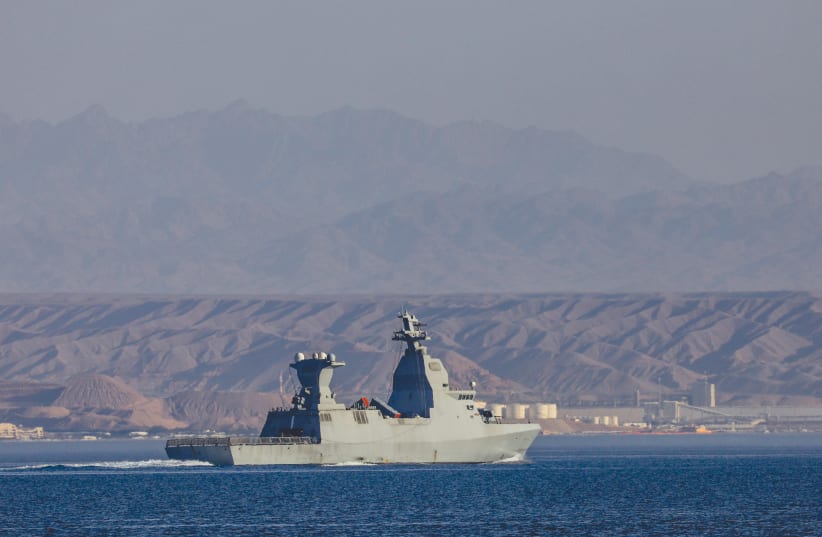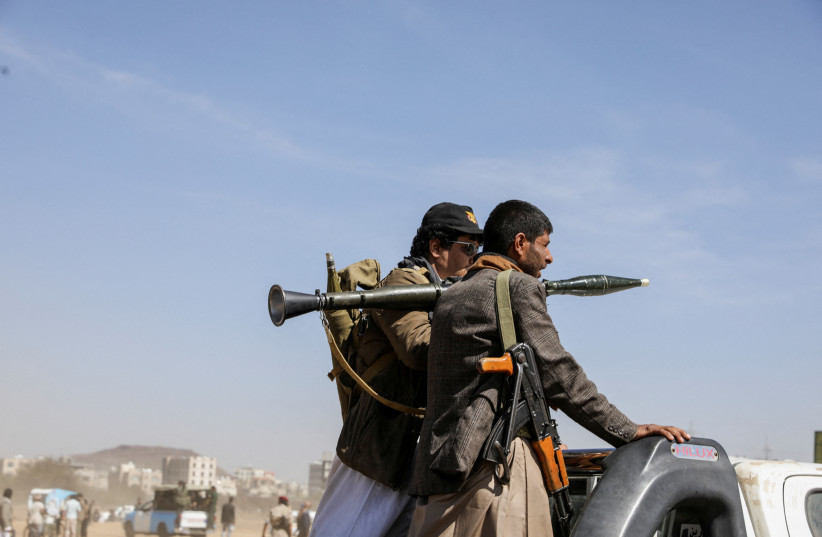The Israel Navy recently used the C-Dome system installed on a Sa’ar 6-class corvette to successfully intercept unmanned aerial vehicles (UAV) that were aimed at Eilat. However, this success should not lead to the false conclusion that the Sa’ar 6 vessels operating in the Red Sea arena should be integrated into Israel’s defense system against missile and rocket attacks on Eilat.
There are three reasons for opposing such a conclusion.
The first is that the C-Dome system was developed for a different scenario, and the second is the ratio of low cost-benefit compared to systems such as Iron Dome that were literally designed for such a scenario. The third is the judgment that their current operation in the littoral water of the Gulf of Eilat could endanger the vessels, as happened to INS Hanit in the Second Lebanon War.
Eilat: a focus point
In 2012, the Israel Navy proposed that the government purchase four Sa’ar 6 corvettes from Germany. These corvettes would be fitted to accommodate advanced radars, tracking systems, and the naval version of the Iron Dome defense system. The government approved the plan and allocated the budget for it. The Sa’ar 6’s primary mission would be to patrol the area of the Israeli gas rigs in its Mediterranean exclusive economic zone (EEZ). The corvettes would protect the gas rigs from various threats, such as missiles and rockets.
As per a resolution, the Defense Ministry signed a contract in May 2015 with ThyssenKrupp Marine Systems of Germany (TKMS), to purchase four Sa’ar 6-class corvettes for the Israeli Navy. During the signing ceremony, the director-general of the Defense Ministry, Maj- Gen. Dan Harel, explained that these vessels are larger than the current Sa’ar class boats and can be equipped with advanced combat systems, allowing them to operate hundreds of kilometers from Israel’s shores.
In May 2023, the navy completed a series of successful interception tests of the C-Dome system on the Sa’ar 6-class corvettes.
During the Iron Swords War, the Houthi rebels in the southern Red Sea and the Gulf of Aden enforced a blockade on shipping to and from Israel. As a response, the Israeli Navy stationed vessels in the Red Sea, which included Sa’ar 6-class corvettes. Israel played a persuasive role in creating the force but opted not to join to allow the US to participate with other moderated countries from the region.
In the resulting situation, the Israeli ships were stationed in the northern Red Sea and the Gulf of Eilat and integrated into the country’s aerial detection and warning system.
It’s worth noting that Eilat port has always posed a significant risk to Israeli vessels, particularly navy ships. In the 1970s, an Egyptian commando squad attacked several cargo and navy ships that were docked in the port. The city of Eilat’s proximity to the borders of Egypt, Jordan, and Saudi Arabia provides an opportunity for terrorist groups to launch rocket attacks on the city from this no man’s land.
On the night of April 1, 2024, a UAV launched from Iran via Jordan successfully evaded air defense systems and hit a maintenance facility at an Israeli Navy base in Eilat. The facility was likely the intended target of the attack. Fortunately, there were no casualties resulting from the impact, however, the facility suffered significant structural damage. This facility caters to the maintenance and supply needs of the navy, including Sa’ar 6 vessels.
On the night of April 8-9, the C-Dome system, installed on a Sa’ar 6-class corvette, intercepted and destroyed a suspicious aerial target launched towards Eilat. On April 14, Israeli the Navy and Air Force identified another suspicious aerial target that had penetrated Israel’s airspace from the Red Sea. In this instance, the Sa’ar 6 also successfully intercepted the target using the C-Dome system.
Additionally, if the conflict in northern Israel escalates with Hezbollah, the Sa’ar 6-class corvettes will need to protect the gas production infrastructure in Israel’s EEZ, a task they were designed for.
THE ISRAELI government has set goals for ending the war in the Gaza Strip and the North of Galilee, and the ongoing public debate is about the ability to achieve them. Regarding securing sea lanes of communication of commercial vessels to and from Israeli ports in the Red Sea, the Israeli government has not set any goals at all.
The public pressure exerted on the government by residents of the Gaza border area and northern Galilee does not exist in the case of the Red Sea because the shipping companies affected by the blockade found a tentative solution with alternative shipping routes.
At the same time, the closure of Eilat port was swallowed up by the more severe plight of the northern Galilee and Gaza border communities.
Presumably, even after the forces of the US-led Operation Guardian of Prosperity have successfully minimized the Houthi threat to the shipping lane in the Southern Red Sea, Israeli Navy vessels will still need to secure sea lanes of communication in the region. In such a scenario, the C-Dome system is expected to play a crucial role.
However, deploying Sa’ar 6-class corvettes to intercept aerial threats in the area of Eilat carries significant risks, as explained above. The vessels’ activity in the northern Gulf of Eilat exposes them to unnecessary danger. Using interceptors on these ships will reduce the number of interceptors available for future tasks that the Navy may need. These tasks may include protecting Israel’s strategic assets in the Mediterranean Sea’s EEZ waters or escorting and securing Israeli shipping as it passes through the unpredictable southern Red Sea and the Gulf of Aden.
The writer, a retired rear admiral, is the director of the Maritime Policy & Strategy Institute (MPS) at the Israeli National Center of Blue Economy and Innovation, Haifa.

